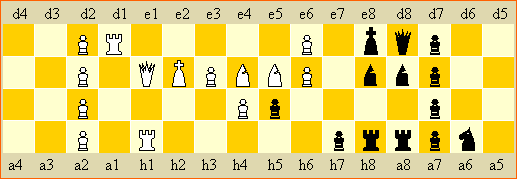Toroidal Byzantine Chess
Introduction
The chess variant which came in Europe from the Arabic countries was Shatranj.
In Byzantium of 1000 A.D. it was played on a circular board instead of a standard square 8x8.
This variant called as Byzantine Chess is now reconstructed in the form of Circular Chess.
The Torus
Chess and Chess
in a Toroidal Board may serve a hint for playing Byzantine Chess
on the torus shaped board.
As soon the edges of the circular board are joined a torus is constructed.
(The rules remain the same, only the geometry is changed).
Perhaps, the Byzantine Chess on the toroidal board has been experienced
in Constantinople,
recently (1999-2001) it was considered by several mathematicians (among
whom the present authors).
On account of exotic geometry this variant belongs better to the scope
of mathematics rather than sport or game.
But for playing for joy it is suited well.
Setup
The initial setup is the same as in Byzantine Chess.It is also convenient to imagine the circular board in the rectangular development which is used for the Java and Zillions-of-Games computer programs playing Byzantine Chess and Toroidal Byzantine Chess.
|
satellite=main
files=16
ranks=4
graphicsDir=/graphics.dir/utrechtPNG/
promoZone=0
maxPromote=0
promoChoice=
symmetry=none
squareSize=33
graphicsType=png
theme=OS
whitePrefix=W
blackPrefix=B
borders=0
firstRank=1
useMarkers=1
holdingsType=0
Pawn::lomWloocF::c1-c4,,n1-n4
Pawn::romWroocF::f1-f4,,k1-k4
Knight:N:ooN::d2,e2,,l2,m2
Bishop::ooA::d3,e3,,l3,m3
Rook::ooR::d1,e1,,l1,m1
Queen::ooF::e4,,m4
King::ooK::d4,,l4
|
|
Rules and Pieces
Usually, the transition from the suqare board to the circular and toroidal board provides additional mobility to the pieces.
The nominal strength of Bishops and Rooks does not depend
on the changes of geometry.
But a Rook on the toroidal board has circular motion either
over the long 16-cell circle (as on the circular board) or over the short
4-cell circle:

The essential changes concern the Knights and
Queens.
There are no edges on the toroidal board and both figures feel themselves
quite well everywhere, while on the circular board their abilities are
restricted at the edges.
On the torus shaped board all 6 squares are always available for the
Knight

and the Queen has all 4 squares

Playing Tips
Perhaps, the most exotic is the Rook rotation along and across and
the Pawns phalanx with no edges at all (now the a-h pawns have two
neighbors). .
Computer Play
- either on the large circular board toroidalbyzantinechess.zip
- or on its rectangular development toroidalbyzantinechess_rec.zip
Sample Game

Black has material advantage (the Knight for 2 Pawns) but position of his King is dangerous.
1. e6xh7++ (capturing across the glued edges) Ke8-f7 (the only move)
2. Rd1-e7+ Kf7-g6 (2. ... Kf7 x f6 changes nothing)
3. Rh1-e1 Bh6 (3. ... g5 x f4 is followed by 4. Re1-e6+)
4. Rg7+ Kxf6 (the only move)
5. Rg7-e7 g5xf4 (this prevents 6. Re1-e6#)
6. Re1-e6+ Kf6-g5
7. Re7-g7+ Kg5-h4 (the only move)
8. Re6-e4# (the Rook strikes from e4 on h4 since the edges are glued)

Contact
To contact the authors (Anatoly Khalfine and Ernst Saperow), please email the authors at the email address you obtain by following this link.Written by Anatoly Khalfine and Ernst Saperow
WWW page created: January 28, 2002. Modified: November 13, 2002.
